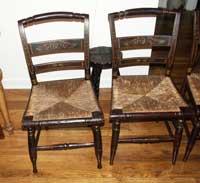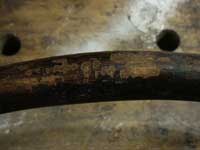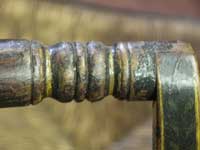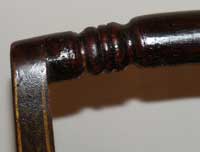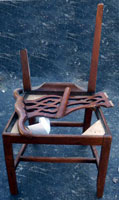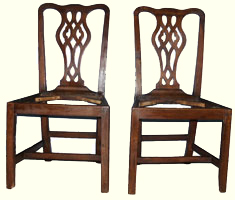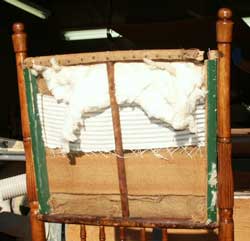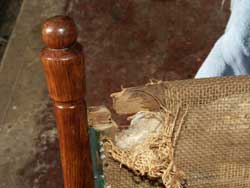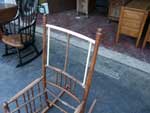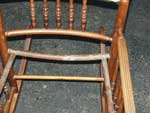


|
Restoration GalleryAntiques High Quality Hand Made Pieces Page 2 "Antique Chair Feature Section"
Hitchcock Chairs Click Here for a Detailed Article on the Hitchcock Chair featured on OldandSold.com These chairs are an example of a conservation effort, as opposed to a full restoration. They are original pieces holding true antique value, making it ill advised to perform any drastic restoration methods involving removing the original finish. In addition, the stenciling work is fragile and difficult to reproduce if removed. Conservation often does not serve to illustrate drastic appearance results, in fact the art is to employ methods that are hardly noticeable yet slow the deterioration process and just slightly improve the condition of the piece. In this case counting for chips and lost sections about 75% of the original finish remains on these chairs. By re-emulsifying the top layers of the finish and spreading the existing media more evenly over the piece covering damaged sections, almost the same percentage of the original finish is maintained. Next, applying an extremely thin additional layer of hand mixed shellac replaces the lost solids from years of chips and bangs are returned. The piece remains within 5% of the starting original finish, plus 15-20% new finish. Application of some new finish also accounts for a slight loss of the original materials that bond to dirt, oils, wax, and general grim removed from the piece during the emulsifying process.
Again part of the art is not going too far, restoring a piece to 100% is like removing the time line from history, as well as most of the antique value. This process works down to about 25% original finish, and also in instances where the original finish is buried under layers of past maintenance refinishes and wax. Keeping the rushing clean while imparting some careful oils to revitalize it and maintain its tensile strength is another key factor, common to chair restoration.
Circa 1790 Chippendale Chairs Chairs in a box! These two specimens apparently came in from Colorado, arriving in just a bit lesser condition than they were expected in. Riddled with powder-post beetle holes, a bit of dry rot, and entirely deteriorated hyde glue these chairs were on their way to a blue ribbon display even with the best of care. Blue ribbon? Ever notice when there's a seat in a museum or location where you're not supposed to sit? There's usually a ribbon over the chair, bench, etc. These pieces are now artwork, a piece of history like a painting. Even in this condition, these chairs hold an antique value of $1500-$2500 and were well worth the restoration effort. Shown below are some of the damaged joints up close. Lots of previous repair attempts, signs of old glue, even a few nails were found in these chairs. Antique "Brewster style" Rocking Chair Arriving with broken and missing spindles and supports, this chair had seen better days. It's ability ability to support stretched fabric let alone a person, was long ago forfeited. Rebuilt slats, spindles, and fresh glued joints restructured the woodwork on this chair and returned it to active duty.
|
|||||||||||||||||||
| home | company background | woodcarving & sculpture | period furniture custom built-in's | services | commissioning process museum/historical affiliations | educational services | craftsmen links sitemap | search |
||||||||||||||||||||
Artisans of the Valley Hand Crafted Custom Woodworking Stanley D. Saperstein Eric M. Saperstein Our studio and showrooms are open by appointment. Please call ahead so we don't miss you! (609) 637-0450 Fax (609) 637-0452 e-mail: woodworkers@artisansofthevalley.com |
